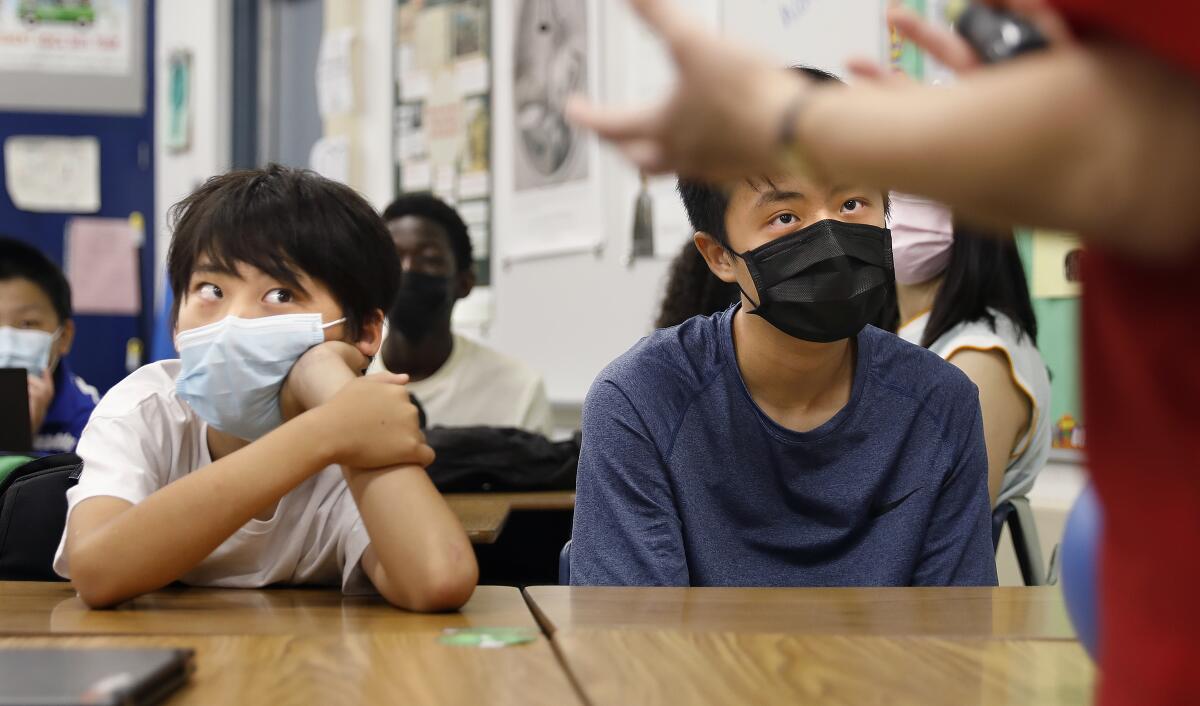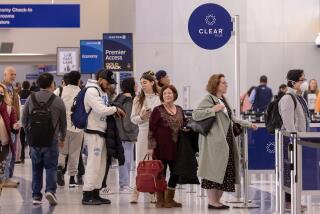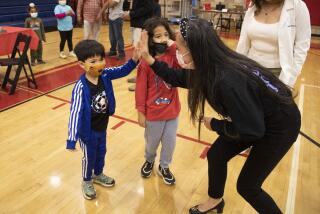New data affirm it. L.A. County school safety policies are working as COVID rates are low

- Share via
The early weeks of fully opened Los Angeles County schools have coincided with declining pediatric coronavirus cases, the first indication campuses are generally operating safely without a troubling number of outbreaks.
Citing the low number of coronavirus outbreaks in schools, public health officials on Thursday announced that schools in L.A. County will no longer be automatically required to send unvaccinated students home to quarantine for at least seven days after their last contact with an individual who tests positive.
Over the last three weeks, coronavirus cases declined across all pediatric age groups by about 40%, according to L.A. County Public Health Director Barbara Ferrer.
“This is promising, since it’s occurring as students are going back to school,” she said during a briefing. “So we’re hopeful, with continued close attention to those school-based strategies that reduce the risk of exposure, we’ll continue to see these lower case rates across all age groups.”
The county has also recently observed downticks in hospitalization rates for children, and Ferrer said that “if our case rates don’t increase, we do anticipate a stabilization or even small declines among pediatric hospitalizations.”
California has directed districts to require masking indoors in K-12 schools, a move at odds with states such as Florida and Texas, whose governors banned school officials from enforcing mask mandates. Texas’ attorney general is suing several districts that have attempted to require masks, while Florida’s governor has threatened to withhold state funding from school boards that attempt to do the same.
The differing policies could be a reason behind the vast differences in pediatric outcomes among children: Florida and Texas have reported records in new pediatric hospitalizations for COVID-19 in the wake of a summer surge caused by the Delta variant, while California remained below the levels of its winter surge.
Florida’s rate of new daily pediatric COVID-19 hospitalization is now six times worse than California’s, while Texas’ is four times worse. The national rate is three times as worse as California’s, according to the U.S. Centers for Disease Control and Prevention.
The CDC this summer recommended universal indoor masking in K-12 schools, regardless of vaccination status.
Los Angeles’ approach to universal coronavirus testing is also increasingly seen as a safety model nationwide. The Los Angeles Unified School District launched an ambitious coronavirus testing program, which requires the screening of every student, teacher and staff member — more than half a million people — once a week for the foreseeable future. The district also requires students and staff to wear masks outdoors.
Neighboring districts also have expanded safety protocols: The Alhambra Unified School District this week began testing students, and Pasadena Unified, which had been only ordering limited testing, is now testing all students regularly.
Last week, the Biden administration called “on all schools to set up regular testing in their schools for students, teachers, and staff consistent with CDC guidance,” which suggests unvaccinated students and teachers be regularly tested for the virus.
Coronavirus cases have remained relatively low among K-12 students countywide as students began returning to campus in mid-August.
From Aug. 15 through Monday, 7,995 cases were reported among K-12 students countywide, with another 1,193 reported among staff. Given that there are about 1.5 million students in this grade range, as well as 175,000 K-12 staff, that means roughly 0.5% of the student body and about 0.7% of the workforce has tested positive since the school year began, Ferrer said.
“This is just slightly higher than the 0.4% rate of infection we experienced overall in the county,” Ferrer said. “And, given the massive testing of asymptomatic individuals at schools, this very low rate of infection affirms the safety that’s provided to students and staff on their campuses.”
There were eight coronavirus outbreaks in K-12 settings last week countywide, up from six the previous week.
Outbreaks are defined as linked cases involving three or more people in which transmission probably occurred at schools or during school activities. Of last week’s outbreaks, six occurred at elementary schools, and two in high school sports settings.
“The number of outbreaks happening at schools really is unusually low,” Ferrer said Thursday.
The revised quarantine policy allows the county’s 80 school districts to adopt a more relaxed policy generally aligned with state guidelines designed to keep students in class. Until now, the county policy was stricter than the state’s.
The revised policy allows a so-called modified quarantine, permitting an unvaccinated student exposed to an infected person to remain in the classroom under certain conditions while the student is tested twice over a weeklong period to see if an infection has developed.
The student, however, will still be ordered to remain at home at all other times except for classroom instruction, having to sit out participation in extracurricular activities, including sports.
An unvaccinated student who had close contact with an infected person qualifies for the modified quarantine only if both were masked for the duration of the exposure. The unvaccinated student must also remain asymptomatic and continue to properly wear a face mask — not only indoors, as is normally required, but also outdoors.
Close contact occurs when a person has been within six feet of an infected person for at least 15 minutes in one day.
The modified quarantine can end on the seventh day after exposure if the second test shows the student has not been infected.
The relaxed quarantine policy can only be used in situations in which officials have not detected a school outbreak. If an outbreak has been detected, unvaccinated students who are identified as close contacts will be required to follow the standard quarantine procedure and be sent home for at least seven days from their last contact with the infected person.
Vaccinated students do not need to be quarantined as long as they remain healthy. Nonetheless, it is still recommended that vaccinated students exposed to someone with a confirmed coronavirus infection get tested five days following exposure.
Children age 11 and younger are not eligible to be vaccinated.
“We feel comfortable that, with relatively low transmission at schools, it’s appropriate to offer schools a modified quarantine option for K-12 students exposed to COVID at schools,” Ferrer said during a news conference.
Ferrer said school districts are not required to adopt the policy, and they should make sure they have the resources necessary to investigate cases.
“You have to be super careful that you know for sure and are able to verify that close contacts to cases had only mask-on-mask exposure,” Ferrer said.
There may be situations in which it will be difficult for school officials to determine whether a student with a confirmed coronavirus infection, and that child’s classmates, were fully masked for the entire duration of the time they had contact with each other.
“It gets complicated when students are doing other activities together, particularly eating lunch or enjoying a recess, where they’re often outdoors and maybe taking off their mask,” Ferrer said. If either the infected person or the unvaccinated, exposed person was unmasked during the period they were in close contact, the exposed person would be sent home to quarantine.
The relaxed, modified quarantine policy does not apply to teachers and staff, meaning that school employees who are still not vaccinated but come in close contact with an infected person would be sent home for 10 days after the last known contact with the infected person.
The L.A. Unified School District has required all teachers and staff to be vaccinated by Oct. 15. But many other districts have not followed suit. California’s rules require that public and private K-12 school employees either be vaccinated or submit to a weekly coronavirus test. Last week, L.A. Unified ordered that all children 12 and older must be fully vaccinated by January to enter campus, the first such mandate among the nation’s largest school systems.
Los Angeles Unified officials did not respond to questions about whether the district would adopt the modified quarantine. They are in negotiations with the teachers union over safety measures. Earlier this month, the teachers union was seeking to expand quarantine practices to everyone on campus, including fully vaccinated employees and students, if they are close contacts with an infected person.
“Quarantining has proven to be an effective mitigation strategy to keep our schools safe and open,” said United Teachers Los Angeles President Cecily Myart-Cruz. “Health and safety must come first to protect everyone who walks through our classroom doors, including children too young to be vaccinated.”
Myart-Cruz did not comment directly on whether she favored or opposed the new county policy on quarantines.
Districts throughout the county were assessing their new option.
The Alhambra Unified School District, for one, does not plan to adopt ease quarantine rules.
Supt. Denise R. Jaramillo said the district’s current quarantine policy is working well so far.
“We have a high community vaccination rate, a low case rate, a robust and motivated team of contact tracers, and a seamless, high-quality virtual program for students who must quarantine,” Jaramillo said. The district launched weekly testing this week for all students regardless of vaccination status, and out of 3,000 tests, identified three positive cases.
The modified quarantine policy will require more vigilance and resources than the district has available, Jaramillo said.
“With teachers already tasked with manifold responsibilities for 25 or more students per class, this added vigilance is asking more than we have staff to affirm,” she said.
Times staff writer Howard Blume contributed to this report.
More to Read
Sign up for Essential California
The most important California stories and recommendations in your inbox every morning.
You may occasionally receive promotional content from the Los Angeles Times.













